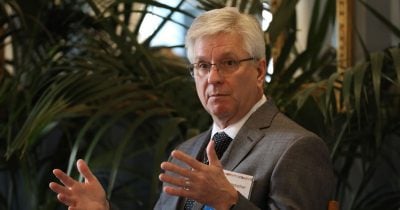When I read a tweet about four noted Silicon Valley executives being inducted into a special detachment of the United States Army Reserve, including Meta CTO Andrew “Boz” Bosworth, I questioned its veracity. It’s very hard to discern truth from satire in 2025, in part because of social media sites owned by Bosworth’s company. But it indeed was true. According to an official press release, they’re in the Army now, specifically Detachment 201: the Executive Innovation Corps. Boz is now lieutenant colonel Bosworth.
The other newly commissioned officers include Kevin Weil, OpenAI’s head of product; Bob McGrew, a former OpenAI head of research now advising Mira Murati’s company Thinking Machines Lab; and Shyam Sankar, the CTO of Palantir. These middle-aged tech execs were sworn into their posts wearing camo fatigues, as if they just wandered off some Army base in Kandahar, to join a corps that is named after an HTTP status code. (Colonel David Butler, communications adviser to the Army chief of staff, told me their dress uniforms weren’t ready yet.) Detachment 201, wrote the Army in a press release, is part of a military-wide transformation initiative that “aims to make the force leaner, smarter, and more lethal.”
The Army’s Executive Innovation Corps (EIC) commissioning ceremony in Conmy Hall, Joint Base Myer-Henderson Hall, Va., June 13, 2025.
Photograph: Leroy Council/DVIDS
Don’t blame Donald Trump for this. The program has been in the works for over a year, the brainchild of Brynt Parmeter, the Pentagon’s first chief talent management officer. Parmeter, a former combat soldier who headed veteran support at Walmart before joining the Department of Defense in 2023, had been pondering how to bring experienced technologists into service to update an insufficiently tech-savvy militia when he met Sankar at a conference early last year. The idea, he says, was to create “an Oppenheimer-like situation” where senior executives could serve right away, while keeping their current jobs.
Both men collaborated on a plan to bring in people like, well, Sankar, who has been a vocal cheerleader of the Valley’s recent embrace of the military, proclaiming that the US is in an “undeclared state of emergency” that requires a tech-led military rehaul. When The Wall Street Journal wrote about the forthcoming program last October, Sankar vowed to be “first in line.”
In a sign that it’s no longer taboo in the Valley to face the fact that its creations go hand in hand with boosting deadly force in the military, the program was fast-tracked and is now in operation. “Ten years ago this probably would have gotten me canceled,” Weil told me. “It’s a much better state of the world where people look at this and go, ‘Oh, wow, this is important. Freedom is not free.’”
The four new officers are full members of the Army Reserve. Unlike other reservists, however, they will not be required to undergo basic training, though they will undergo less immersive fitness and shooting training after induction. They will also have the flexibility to spend some of the approximately 120 annual hours working remotely, a perk not offered to other reservists.
The Army also says that these men will not be sent to battle, so they will not be risking their lives in potential theaters of war in Iran, Greenland, or downtown Los Angeles, California. Their mission is to use their undeniable expertise to school their colleagues and superiors in the military on how to utilize cutting-edge technologies for efficiency and deadly force.
One might assume the Army would have done an extensive study of the specific talents required for this pilot program and pulled those people from an open call for the best candidates. That did not happen. Sankar helped recruit the other three future officers—all male, which by intention or coincidence seems to satisfy the anti-DEI bent of today’s military—and they all accepted. According to Butler, “Lieutenant colonel Sankar said ‘I want to wear the uniform. And I have three other guys willing to go with me.’” Weil confirms that he joined after a request from Sankar. (Parmeter said to me that since this is a pilot program with an unknown outcome, a closed process was appropriate.)
Clearly, the four new officers genuinely want to serve their country. Weil, who I’ve known for years, told me that when Sankar explained the program, “I was just like, ‘Yes, I want to help—that sounds amazing.’” But during a wave of widespread unease over privileges of tech elite—did you see those disgusting billionaire bros on that show Mountainhead?—special arrangements for well-off digital achievers seems tone-deaf.
My big question is whether these men could have provided the same assistance from the private sector. Parmeter and Butler both cited precedent of cases where top executives were directly commissioned, including a top railway executive in 1917, the head of a gas and electric company in 1944, and the General Motors Company president in 1942. But those were full-time roles during world wars. Parmeter also reminded me that many currently serving reservists are already in the tech industry, including, he claimed, some generals at Google(!). Presumably none of them, however, began their military careers as senior officers, and they presumably do not receive special dispensation to perform some of their service from home.
Another program, the Defense Digital Service, gives tech workers a chance to lend expertise to the Pentagon full time for up to two years. What’s more, Parmeter conceded that the military already has a trusted adviser program, where civilians could work part or full time on projects. “That’s obviously still going on, and that’s something that is useful,” he says. “But in this case, we wanted to go beyond that.”
The Army says that there is no conflict of interest in having these privately employed officers provide advice on high-tech subjects. They will have no say in what contracts the Army makes with the private sector. The expertise they offer, however, seems inseparable from the sectors of AI, VR, and data mining at the center of their companies’ business models. Maybe it’s just bad timing, but the month before Bosworth was sworn in, Meta announced a deal with Anduril, a defense contractor co-founded by former fired employee Palmer Luckey, to pursue military contracts.
Around the time lieutenant colonel Weil raised a hand beside Boz, OpenAI announced a $200 million defense contract: it’s also working with Anduril to develop an air defense system. Sankar’s employer Palantir has billions of dollars worth of government deals, including a $759 million Army contract for advanced AI systems. (Thinking Machines Lab, which McGrew advises, is still in semi-stealth, so there’s no news of its plans for military contracts.) Also, while these soldiers are serving in a personal capacity, their employers will undoubtedly benefit from the inside-the-perimeter knowledge that they will gather while simultaneously working on military contracts.
Lieutenant Kevin Weil, OpenAI’s head of product and Army Chief of Staff Gen. Randy A. George
Photograph: Leroy Council/DVIDS
OK, so what will they do? Parmeter provides a hypothetical scenario: the commander of the Indo-Pacific region is figuring out how to address threats in the Far East over the next five to 10 years. They might ask Detachment 201 to tell them how the future state of machine learning and AI would affect security in that context. Or, the new officers might operate more tactically, advising how soldiers could use new tools to understand battlefield conditions.
This kind of sounds like … consulting. Weil argues, however, that advice coming from an actual officer would be more seriously heeded: “There’s nothing wrong with being a contractor,” he says. “But if we’re off supporting an exercise somewhere, it’s different that we’re wearing the same uniform, having taken the same oath.”
A more serious consequence might come from these men having dual loyalty when setting policy at their private companies. Companies like Meta, Open AI, and Thinking Machines Lab are helping create superintelligence that could profoundly impact the world. OpenAI is among those companies that prohibit their models from being used to harm others, and that includes developing weapons. But the mission of the US military is exactly the opposite. Working inside the Army, these recruits are explicitly charged with making the technologies more lethal—in fact, in a hearing this very week, Army secretary Daniel P. Driscoll told senators that the Army Transformation Initiative, which involves Detachment 201, will eliminate programs that do not contribute to lethality.
Who will these officers be serving when they make those determinations? (Weil emphatically tells me that his service is a personal matter, and in any case there are plenty of uses for AI in the military that don’t involve killing.) When I brought this issue up to Parmeter, he said that when determining the direction of future AI at their companies, the officers’ wider perspective would be a plus. Then again, Parmeter did mention Oppenheimer, who created the atom bomb.
Bottom line: Sankar, Bosworth, Weil, and McGrew are soldiers now, even if critics are already accusing them of being rich tech bros cosplaying the real thing. Considering the optics, they would do well to avoid any chest-thumping. Weil displayed humility when I spoke to him. But an op-ed Sankar wrote in the Free Press to explain his motives hit a sour note. Though much of it set out the benefits of a private tech industry in sync with the military, and his family’s inspiring American immigrant story (which might not have happened under current Trump policies), he veered into self-aggrandizement. “None of these men need to pad their résumé,” he wrote of his Detachment 201 blood brothers and, by implication, himself. “None have free time between fatherhood, demanding day jobs, and a dozen other demands. But all feel called to serve.”
Forgive me for thinking that their sacrifices rank in the bottom rung of what the vast majority of soldiers experience. In our conversation, Weil, again, was humble about becoming an instant senior officer, a rank given to reflect his achievements in private life. “I’m still a little bit sensitive to the title, because there’s so many people that have given their lives or spent their lives dedicated to this,” he told me. “So I want to earn the title.”
I have no idea how their Army-mates will regard them, but all who hold lower ranks, including life-long soldiers and veterans of combat, will be required to salute the Detachment 201 lieutenant colonels on sight. According to Butler, these overnight officers haven’t yet mastered the art of crisply returning those salutes. “They’ve got a bit of work to do,” he told me.
Time Travel
Weil is correct when he says that a decade ago, Silicon Valley would have condemned him for accepting his post. He was working for Facebook as Instagram’s head of product during the time that Luckey was tossed out of the company for supporting Donald Trump and lavishingly expressing his fondness for the military. In my book Facebook: The Inside Story I describe how in 2016 Palmer Luckey alienated Mark Zuckerberg and the Facebook workforce—by acting like Zuckerberg would act in 2025. All is copesetic now as the two are partners in developing VR technology for today’s military.
Luckey was a political conservative, supporting the right wing with the same enthusiasm he devoted to fast food, cosplay photos with his girlfriend, and soldering artisanal computer peripherals. He was a huge admirer of the military. [Brendan] Iribe [cofounder of Oculus] remembers that he once got a call saying Luckey had driven a tank on the Facebook campus. The police had been called. The vehicle was Luckey’s Humvee, repurposed from military service with toy machine guns attached to the postings. [The orange-colored guns were clearly not operational.] To Facebook’s workers though, it might as well have been a nuclear bomb. Luckey defused the situation and wound up posing for pictures with the cops, but the incident was a black mark on his record. “Here at Facebook, you can’t drive Humvees with guns—military vehicles—onto the lot and have the police show up,” says Iribe. “That’s not what we’re focused on here.”
Ask Me One Thing
Madhu on Bluesky asks, “If all of us adopted AI to write our medical clinic notes, how will that impact our carbon footprint?”
Thanks for the question, Madhu. You are correct in implying that AI large language models consume considerable electricity. Writing medical clinic notes probably isn’t the biggest worry, though. The actual numbers are fuzzy, maybe intentionally. But according to Nature, for a chatbot to find something, it consumes 23 to 30 times the energy of a Google search. And it’s going to get worse.
For instance, consider AI agents, which nearly everyone agrees are the next step for LLMs. I recently learned that compared to simple prompts and outputs, tasks where LLMs essentially query the world to fulfill and verify people’s requests have jaw-droppingly higher power demands. Nvidia CEO Jensen Huang has estimated that reasoning-based agentic AI will require 100 times the computation, and thus the power consumption, of the current paradigm. As you suspect, this will not be great for the environment.
Submit your questions in the comments below, or send an email to mail@wired.com. Write ASK LEVY in the subject line.
End Times Chronicle
In a “Bible Prophecy Update,” Christian commentator Greg Laurie cited “super signs” in the Middle East that the Last Days may be on track and advised readers to prepare.
Last but Not Least
How activists helped Elon Musk pay the price for DOGE-ing the government.
Visiting the United States or returning from a trip abroad? Here’s how to protect your information at the border when you return.
A bulked-up visit to the Steroid Olympics.
Former WIRED editor Megan Greenwell talks about her book on private equity. She’s not a fan.
Don’t miss future subscriber-only editions of this column. Subscribe to WIRED (50% off for Plaintext readers) today.




